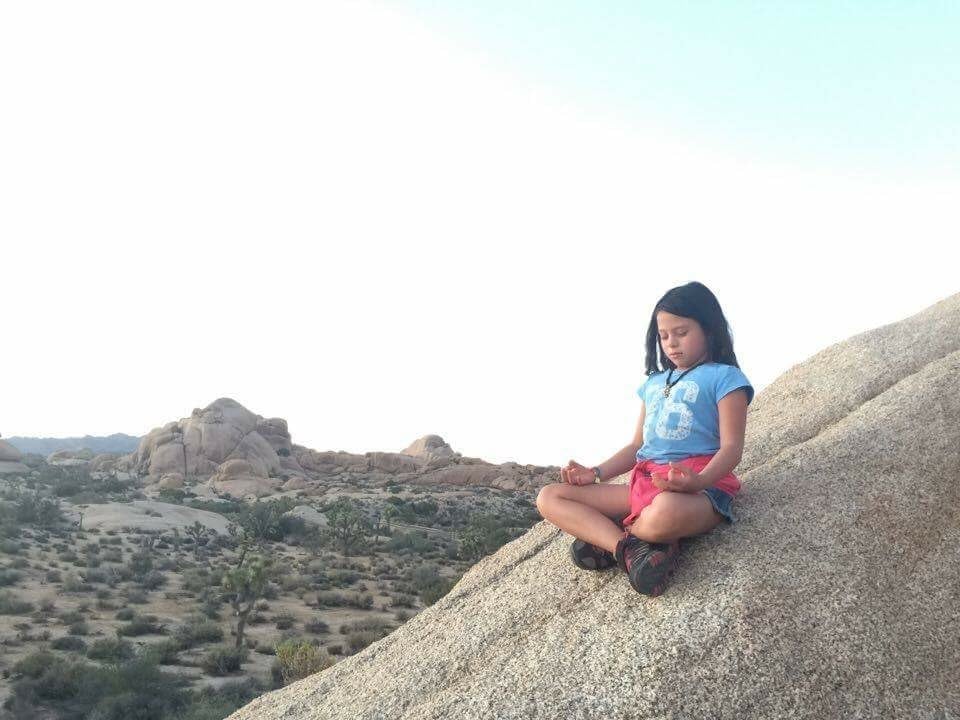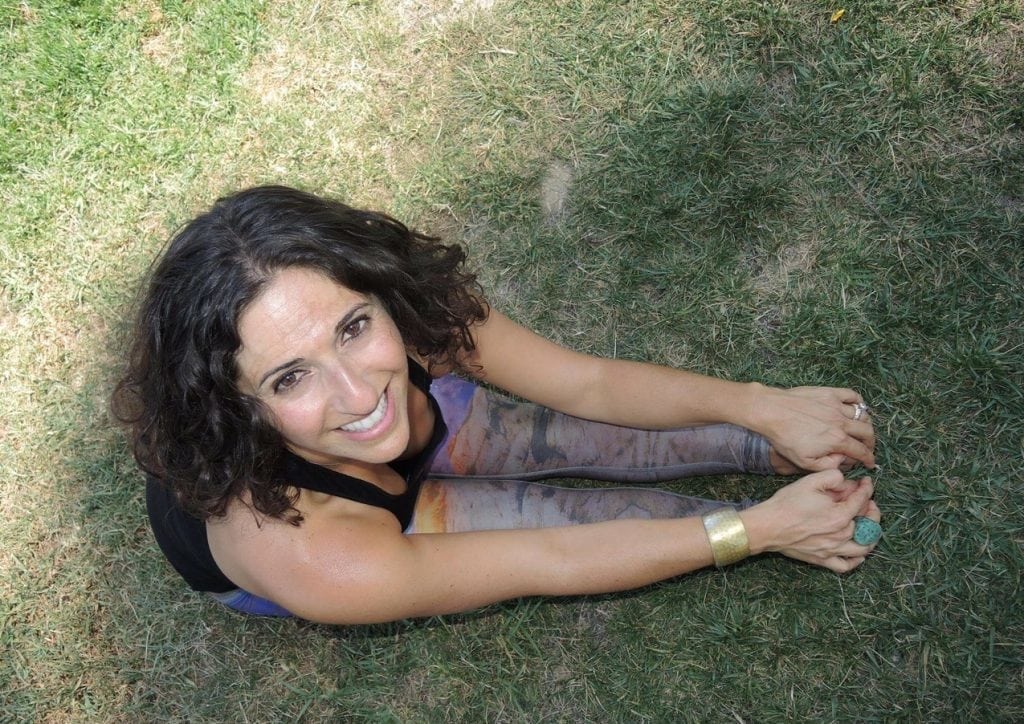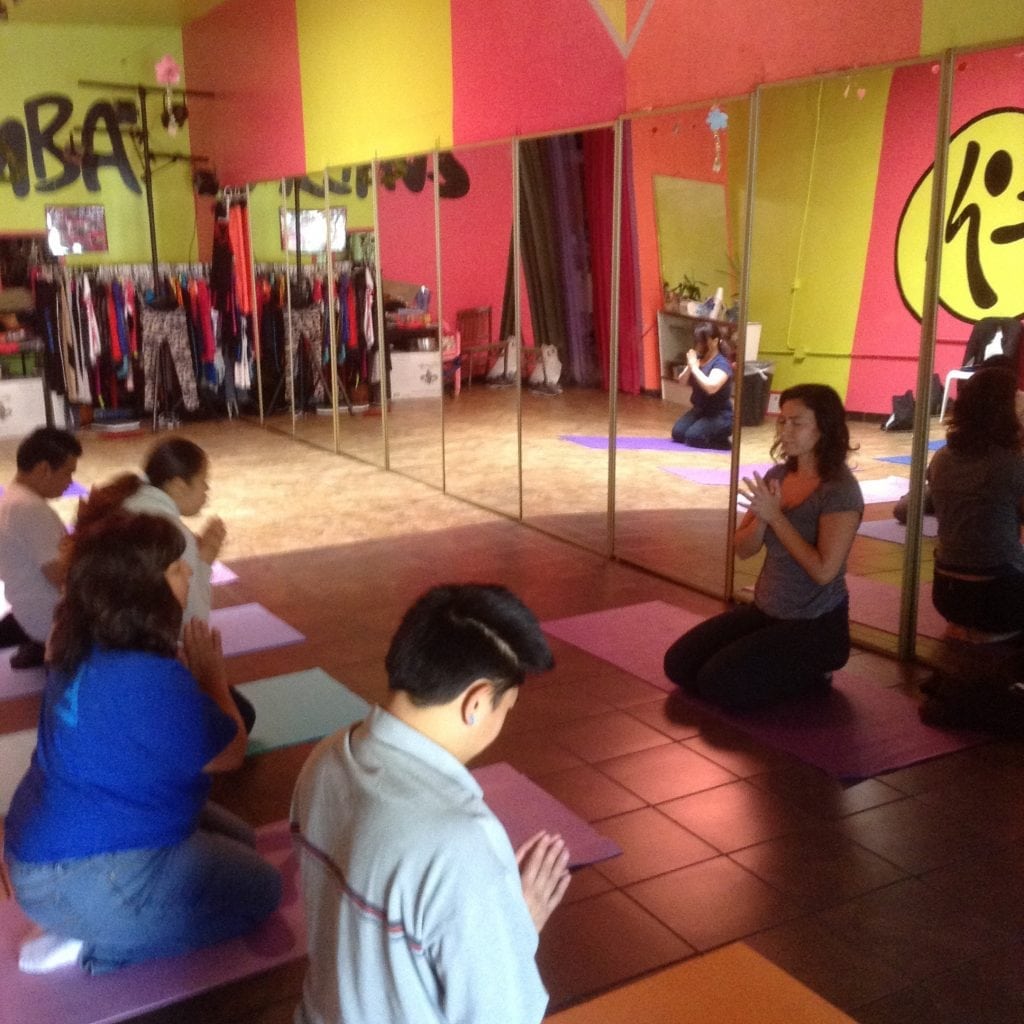
Luciana Sanchez, 9, took meditation classes and looked online when she wanted to continue her practice at home. PHOTO COURTESY THE SANCHEZ FAMILY
Meditation is a simple tool that can help kids develop focus and feel more calm. And it can be enjoyable. Parents can meditate with kids in playful ways that create safe space for emotions to surface and imaginations to be set free. But getting there takes some practice.
Mindfulness practice and meditation are different for kids than for adults, but their purpose is the same: to build awareness by taking time out to be with the breath, body and mind.
Helping children learn meditation is easiest if we acknowledge that they are not mini-adults. “You can’t expect children just to sit,” says Karen Kazanci Voskanian, a yoga instructor at Silverlake Yoga who has been teaching children meditation for more than a decade. “When adults first start meditating, they can sometimes sit still, although who knows what’s going on in their brain. For kids that restlessness is on the surface.”
Working With Restlessness
One solution is to start with movement or talking to get the jitters out. Then, kids become ready to sit – for short periods at first. Samantha Snowden, mindfulness facilitator at the Peak Brain Institute in Culver City, has her students start with one minute of sitting still then discuss what that felt like, eventually working up to five minutes at a time.
Snowden teaches mindfulness meditation, which is defined as paying attention on purpose with openness and curiosity and a willingness to be with what is. But Snowden says children often pay attention in a way that’s “much more participatory.” So instead of having kids sit still, Snowden might print out some mandala coloring pages and have her students spend five minutes coloring them, looking only at their own paper and focusing on that. When kids are having fun, they set aside thoughts more easily, become more present and are able to direct their focus inward.
Some students resist the silence that comes with sitting, but others crave it. “Silence is a safe place for kids,” says Milena Hunter, a yoga instructor at Mission Street Yoga in South Pasadena and Still Yoga in L.A., who teaches children with special needs in the Los Angeles Unified School District. “Having it can change how they feel and help them maintain peace.”
Reaping the Benefits

Karen Kazanci Voskanian, a yoga instructor at Silverlake Yoga, has been teaching children meditation for more than a decade. PHOTO COURTESY KAREN KAZANCI VOSKANIAN
With that peace can come many other benefits. Voskanian has noticed that her students become more calm, present and aware of their bodies, and has seen meditation practice help kids make academic and behavioral shifts. “One student was told that her writing became more creative,” she says. “Another student had a lot of anxiety and had physical effects like vomiting. Our focus on deep breathing helped that calm down.”
Snowden works with many children who have anxiety, depression and trouble paying attention. She says meditation helps children learn how to pay attention, not just that they should pay attention.
While meditation teachers sing the practice’s virtues, you shouldn’t expect an instant transformation. “Don’t think it’s going to be a magic bullet,” cautions L.A.-area yoga teacher Cecilia Ussher. “A kid might sit still for five minutes but this might not directly translate into all of his behavior right away.” She suggests praising kids for self-awareness outside of meditation as a way to promote mindfulness throughout the day.
Modeling Mindfulness
It helps if parents participate in a meditation practice with children. “The number-one thing that parents can do is model meditation,” says Ussher. “I recommend parents meditate themselves and with their kids.”
Hunter’s high school students have many distractions – some serious like the threat of their parents being deported, and some more day-to-day like the buzzing of a smartphone. If you are able to turn your phone off while you practice with your children, that will be a positive model.

Milena Hunter is a yoga instructor at Mission Street Yoga in South Pasadena and Still Yoga in L.A., and teaches children with special needs in the Los Angeles Unified School District. PHOTO COURTESY MILENA HUNTER
That said, technology can also help with meditation. Luciana Sanchez, who is 9 years old and took meditation classes with Snowden at The DEN Meditation in L.A., looked online when she wanted to continue her practice at home. “We search ‘meditation for kids’ on YouTube. We have a favorite one of a girl holding a moon,” she says. Sanchez likes to follow along with guided meditations online “because it shows a lot of the instructions.”
Finding a Space
While meditation masters might be able to find zen in a cave, a chaotic setting or anything in between, we mere mortals and our kids can start where we are. This could be at home or not far beyond in outdoor spaces.
At home, pick a quiet place and use the same spot each time you practice meditation. Voskanian encourages this to reinforce a routine, making it enticing by co-creating a ritual that is special to all of you. “Kids are very aware of their senses, so construct the ritual with that in mind. Light a scented candle, allow a piece of chocolate to dissolve on the tongue while they sit or chant a song together,” she says. “Also, when children first start meditating, have them sit against a wall until they build their postural muscles.”
Besides starting a home practice, here are three places in Los Angeles where kids can meditate and explore their breath and senses in new ways:
- Near the ocean: In addition to teaching meditation to children, Voskanian also works at the Malibu Foundation as an educator, so, naturally, she suggests the beach as a place to meditate. Breathe in and out with the sound of the ocean in the background.
- Self-Realization Fellowship Lake Shrine: At the Fellowship’s meditation gardens, located at 17190 Sunset Blvd. in Pacific Palisades, children can experience being in a space among other people looking for quiet. The shrine is open from 9 a.m.-4:30 p.m. Tue.-Sat., noon-4:30 p.m. Sun.
- Griffith Park Sundial: Outside the Griffith Observatory, 2800 E. Observatory Road in Griffith Park, is a sundial surrounded by a grassy area. Take your children to this ring so they can meditate while seeing time’s seemingly slow passage.

L.A. yoga teacher Cecilia Ussher recommends parents be relaxed about their meditation practice with kids. PHOTO BY RUDY ESPINOZA/PEOPLE’S YOGA
Meditations For All Ages
Wherever you practice, be flexible. Hunter points out that Monday morning meditation after the weekend is different (sleepier) than on a Thursday afternoon. Ussher recommends parents be relaxed about the style of meditation with children. “They don’t have to close their eyes or be still,” she says.
Also keep your sessions fun, light and age appropriate. Don’t insist your child meditate daily, or at all. Be aware that while there are some consistent threads in mindfulness practice, such as a connection to the breath and being open to being in stillness, the length the focus on the breath and stillness last will vary based on age and individual child.
Here are some sample meditations:

Samantha Snowden, mindfulness facilitator at the Peak Brain Institute in Culver City, has her students start with one minute of sitting still. PHOTO BY JULIAN ROMERO
For ages 4-7: “I use the image of a thermometer and ask the children, as the temperature rises, What does it look like? What does it feel like? Can I catch my fear (or other emotion) at a three before it rises to a nine?” says Snowden.
For ages 8-10: “Some children go deeper into their meditation if they lead it,” says Voskanian. “Have your child tell you how many breaths she feels ready for (15 to 20), then have her lead the inhales and exhales up to that number.”
For ages 11-13: “Send friendly wishes,” says Snowden. “Pick someone you find easy to love and send these to them to help relax or go to sleep.”
Always take time, after practice, to reflect with your children. Make sure whatever meditation practices you are doing together are working for them. Engage them by asking how they felt in their meditation.
If one meditation game or practice does not feel fun, find another one. Meditation is a practice that is not supposed to make perfect.
Laura Riley is a writer, yoga teacher and social justice attorney.






































